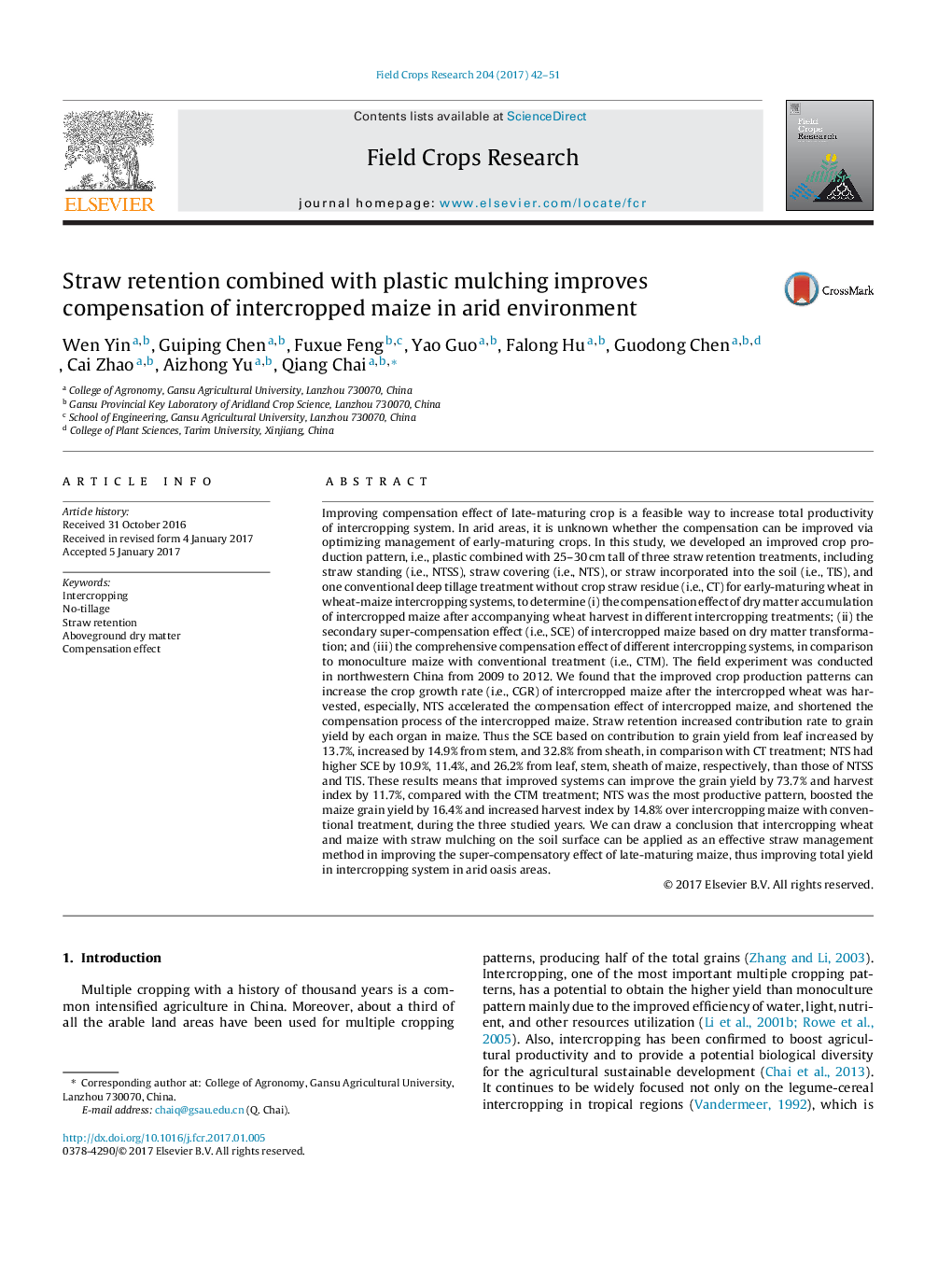| کد مقاله | کد نشریه | سال انتشار | مقاله انگلیسی | نسخه تمام متن |
|---|---|---|---|---|
| 5761609 | 1624659 | 2017 | 10 صفحه PDF | دانلود رایگان |
عنوان انگلیسی مقاله ISI
Straw retention combined with plastic mulching improves compensation of intercropped maize in arid environment
ترجمه فارسی عنوان
نگهداری نیهای همراه با مالچ پلاستیکی باعث کاهش جبران ذرت بین دانه در محیط خشک می شود
دانلود مقاله + سفارش ترجمه
دانلود مقاله ISI انگلیسی
رایگان برای ایرانیان
کلمات کلیدی
کشت مخلوط، بدون خاکورزی، نگهداری کوه، ماده خشک زیرزمینی، اثر جبران،
موضوعات مرتبط
علوم زیستی و بیوفناوری
علوم کشاورزی و بیولوژیک
علوم زراعت و اصلاح نباتات
چکیده انگلیسی
Improving compensation effect of late-maturing crop is a feasible way to increase total productivity of intercropping system. In arid areas, it is unknown whether the compensation can be improved via optimizing management of early-maturing crops. In this study, we developed an improved crop production pattern, i.e., plastic combined with 25-30Â cm tall of three straw retention treatments, including straw standing (i.e., NTSS), straw covering (i.e., NTS), or straw incorporated into the soil (i.e., TIS), and one conventional deep tillage treatment without crop straw residue (i.e., CT) for early-maturing wheat in wheat-maize intercropping systems, to determine (i) the compensation effect of dry matter accumulation of intercropped maize after accompanying wheat harvest in different intercropping treatments; (ii) the secondary super-compensation effect (i.e., SCE) of intercropped maize based on dry matter transformation; and (iii) the comprehensive compensation effect of different intercropping systems, in comparison to monoculture maize with conventional treatment (i.e., CTM). The field experiment was conducted in northwestern China from 2009 to 2012. We found that the improved crop production patterns can increase the crop growth rate (i.e., CGR) of intercropped maize after the intercropped wheat was harvested, especially, NTS accelerated the compensation effect of intercropped maize, and shortened the compensation process of the intercropped maize. Straw retention increased contribution rate to grain yield by each organ in maize. Thus the SCE based on contribution to grain yield from leaf increased by 13.7%, increased by 14.9% from stem, and 32.8% from sheath, in comparison with CT treatment; NTS had higher SCE by 10.9%, 11.4%, and 26.2% from leaf, stem, sheath of maize, respectively, than those of NTSS and TIS. These results means that improved systems can improve the grain yield by 73.7% and harvest index by 11.7%, compared with the CTM treatment; NTS was the most productive pattern, boosted the maize grain yield by 16.4% and increased harvest index by 14.8% over intercropping maize with conventional treatment, during the three studied years. We can draw a conclusion that intercropping wheat and maize with straw mulching on the soil surface can be applied as an effective straw management method in improving the super-compensatory effect of late-maturing maize, thus improving total yield in intercropping system in arid oasis areas.
ناشر
Database: Elsevier - ScienceDirect (ساینس دایرکت)
Journal: Field Crops Research - Volume 204, 15 March 2017, Pages 42-51
Journal: Field Crops Research - Volume 204, 15 March 2017, Pages 42-51
نویسندگان
Wen Yin, Guiping Chen, Fuxue Feng, Yao Guo, Falong Hu, Guodong Chen, Cai Zhao, Aizhong Yu, Qiang Chai,
